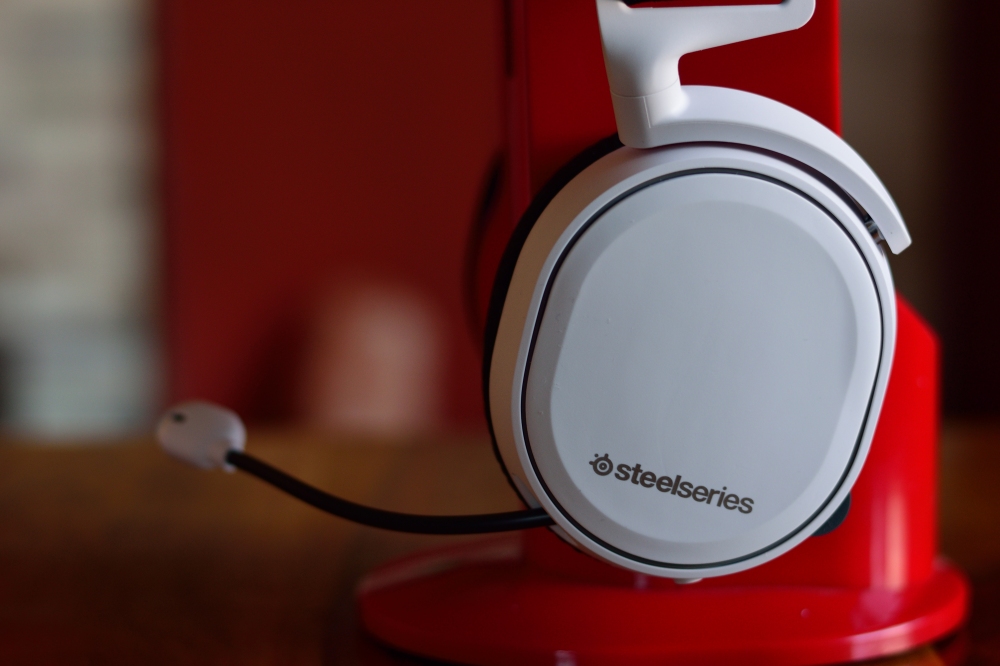
Review sample supplied free of charge by Steelseries.
Oh, the freedom of having no wires attached to you yet still being able to chat with friends or listen to music while wandering around naked in your own home clutching a bowl of coco-pops like it’s the only thing left in your life worth anything. Yup, the wireless age is a golden one, or at the very least a yellowish tinged one. Since I reviewed it I’ve been using the Arctis 5, a wonderful wired headset that had great sound and didn’t break the bank. But now I’ve got my grubby mitts on its bigger brother. There are no strings on the Arctis 7, it’s cord has been cut. But is it any good?
Visually I have to admit that the matt white finish that my test sample of the Arctis 7 came with is gorgeous, although it also meant I was constantly worried about getting dirt on it. I became obsessed with cleaning it, then putting it back on the headphone stand to be admired. It’s my precious, you see. My precious. Mine alone. There’s not even a hint of RGB lighting either, which in 2018 is something of a miracle. I’ve said before I’m a fan of RGB LEDs, but their absence here isn’t an issue and helps battery life. Instead, some extra visual flair can be added via new headbands you can pick up off of the Steelseries store, though I can’t imagine many people doing that. Overall, I really like the clean, sleek aesthetic of the Arctis 7.

Once again SteelSeries have gone with the ski-band suspension system that worked so well on the Arctis 5 I reviewed previously. Basically, rather than adjustable pull-outs on each side of the headset, you have an elasticated band of fabric that sits below the metal frame that gives the headset its structure. This ski-band can be adjusted using a simple velcro strip, but is otherwise self-fitting and I have to say that I found it to be wonderfully comfortable. The light fabric padding on the earcups isn’t quite thick enough so those with a wider head might find their ears touching the drivers tucked away in the earcups, but otherwise is very nice and breathable. For my head size, which is fairly small, I found the level of force that the Arctis 7 clamps onto the skull with to be pretty much perfect with the ski-band providing just the right amount of support. The end result was wonderfully comfortable. In fact, this is probably the most comfortable headset I’ve ever worn. With that said, if you have a larger head you might find the clamping force too much, or you may even find that there simply isn’t enough room between the ski-band and the metal frame that sits above it. A little bit of padding on the metal band just in case may have been helpful.
Build quality is generally excellent. The swivel on the earcups is perhaps a bit too loose, but everything else feels solid and like a premium product, which is good considering the premium price-tag of £150. If you pick it up and stretch it, jiggle and generally prod it there isn’t a creak or a squeak to be found. The soft plastic finish on the outside of the earcups is also a nice touch as it gives you something to fondle. Er. Y’know, if you’re into that kind of thing. Ahem.
On the left ear-cup there is a nice volume wheel for quick adjustment without having to go back into Windows, but while it is nice and smooth the lack of notches means getting a precise volume can be tricky. You’ll also find the mute button for the microphone which sits flush with the rest of the plastic when it is not muted, making it a tad troublesome to find with your fingers, but you’ll get used to the positioning. You’ll also find a 3.5mm jack so that you can hook the headset up to a variety of other things, as well as the charging port.

On the right ear-cup, there’s another wheel, this one for controlling the balance between chat volume and the game sound with a notch at the mid-way point. This feature does require you to set it up properly through Windows, but the small hassle is worth it as I found it to be a very useful feature. The power button is below that, and again there’s a small quality of life problem here; it’s small and sits flush with the rest of the plastic so it’s a little awkward to feel with your fingers. Steelseries themselves seem to have know this as there’s a long oval surrounding it that is made of a smoother plastic than the rest.
The battery life isn’t as impressive as the HyperX Cloud Flight I reviewed recently, with the Arctis 7 having an advertised life of 20-hours compared the Cloud Flight’s 30. Recharging is as simple as plugging in the included USB-to-Micro-USB cable, and a flashing light on the microphone will inform you of when it has finished munching electricity. Speaking of which the power button will flash green, amber and red when being turned on to indicate how much charge is left, and you can also check out the software where a small icon indicates, Weirdly, though, the software indicator only shows you battery life in chunks rather than a more precise percentage. Why, Steelseries, why?
Hidden away in the left earcup like some sort of skulking assassin waiting to slay the ears of others with your hideous voice is the retractable microphone which features an annoyingly bright red light on the tip that turns on when the mic is muted. In what is quickly becoming a theme with headsets, though, Steelseries seems to have sunk the budget into everything other than the microphone, so the voice quality is merely passable, although I have to admit that it’s better than the majority of gaming headsets. Clarity is okay while bass is lacking so voices come through sounding weak and flat, but the noise cancellation is reasonable and there’s minimal pop. The end result is that you can communicate with your friends but if you really want someone to understand what you did to their mum last night in perfect clarity then there are better options out there. Still, I think for most people this will do the job nicely unless you happen to be a Youtuber or Streamer, in which case you’re probably better off getting a separate microphone anyway.

The connection is handled via a little black puck that you plug in using the lengthy USB cable, so you have a good amount of freedom to place it close by. This little round piece of magical technology also has a line-in and a line-out which can be used to route your speakers, the idea being that when you turn the headset on Windows will automatically swap over to the headset. Neat, huh?
As for compatibility the 3.5mm jack obviously means you can hook it up to quite a few things. Using the USB puck you can also hook it up to a PS4 where the wireless will work just fine. There’s no official Xbox One support, though, which is a shame.
Right, let’s get to the juicy topic; how do these babies sound? 7.1 virtual surround (in this case the DTS Headphone X kind) sound is one of those intriguing gimmicks because it has some great potential, but comes with a few key tradeoffs. Whack it on via the SteelSeries software and you do get a more expansive feel to the sound which can be great for a heightened sense of immersion, especially in movies with good audio and it is a tiny bit easier to pinpoint sounds versus standard stereo, which is actually a compliment to how damn good the stereo option actually is, but we’ll get back to that. For these benefits, though, you do lose some of the detail in the audio quality, with voices, in particular, sounding hollow and echoey. And for God’s sake never use 7.1 on Youtube. *shudders*
So let’s talk about the stereo sound; it’s bloody good. The 50mm drivers may not be able to compete with proper studio-grade monitors or some of the better audiophile headphones you can pick up even at a reasonable price, but one should always remember that gaming headsets do tend to have different focuses for better or for worse. What we get here is a nice, detailed audio that packs a punchy bass, warm mids and slightly lacking highs that are still perfectly good. If you plug in the 3.5mm jack you can definitely pinpoint some extra clarity coming from the cord that isn’t there on the wireless mode, but that’s not surprising. I mean, it’s sending stuff through the air. It’s like, magic, man. Positional audio on the stereo mode is also strong, letting you pick out the precise direction of gunfire, footsteps, explosions and more.
Via the SteelSeries Engine software, you can play around with the audio using some simple equalizers, as well as turn on things like sidetone for the microphone. The software is easy to use and navigate and has several presets in case you don’t want to fiddle around with anything, but the default setting is the best of the bunch.
So the big question is does the Arctis 7 replace my beloved Steelseries 840 that is still hooked up to my TV, Xbox One and Blu-ray player? Well, not quite, but that’s largely because the Arctis 7 doesn’t have the swappable battery system which I freaking adore so much. That gripe aside, however, this is a hell of a wireless headset. I found it to be comfortable and it sounds great as well as having very good build quality. The microphone could be better and the battery life isn’t top of its class, but both are still quite good. The only thing holding it back is the RRP of £137 as listed on Amazon. That’s a lot of cash, though you can pick it up for quite a bit cheaper. Price is always subjective, though, and what you may be willing to pay for quality might not be the same as someone else. So, with all of that said these are bloody good, and they’re getting my recommendation.
Follow @wolfsgamingblog

Never had the chance of trying out a 7.1 headset. I wonder how much difference there will be between one of these and my stereo headset. Especially in games.